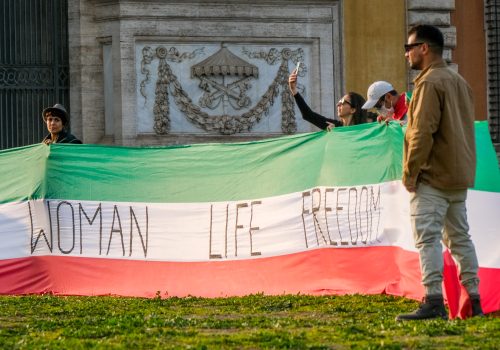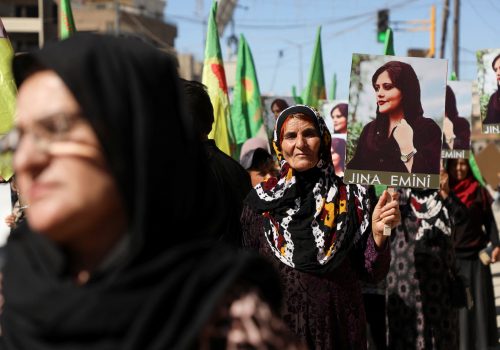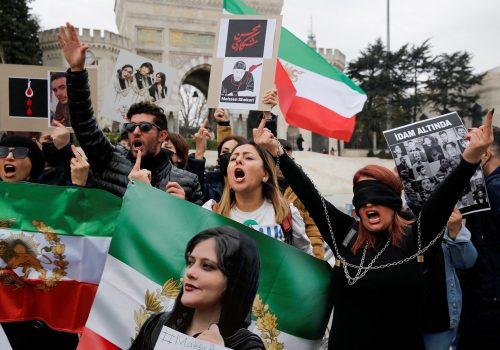Springtime in Iran signals the renewal of an environmental movement
Across diverse cultures, the arrival of Spring evokes literary connotations as a period of hope and revival. The term often appears in association with political upheavals—consider the example of the Arab Spring.
For Iranians, Spring is particularly significant as its arrival coincides with the start of the Iranian New Year, Nowruz, which translates to “new day.” It is celebrated with thirteen days of rituals centered around rejuvenation and nature. This year, however, the dawn of Spring was particularly bittersweet for most Iranians around the world, as it marked six months since the mid-September 2022 murder of Mahsa Jina Amini, while in police custody for “violating” the Islamic Republic’s dresscode. This ignited widespread protests across the country and coincided with a growing desire among Iranians for revolutionary change.
Although there has been a decline in the size and frequency of protests in recent months, the onset of Spring serves as a reminder that the goals of the Woman, Life, Freedom movement are perennial. Moreover, the transition to Spring and the anticipation of warmer months brings to light environmental issues that direct attention to the Islamic Republic’s ongoing failures.
Environmental degradation
As temperatures rise, existing seeds of discontent are likely to germinate. The Iranian environmental movement is deeply rooted in the nation’s social and economic issues. Given the country’s scarce water resources and disproportionate vulnerability to the impacts of climate change, environmental issues can act as a “threat multiplier” to the viability of the Islamic Republic.
Exacerbated by decades of isolation, mismanagement of local resources, and the consequences of a prolonged drought, Iran’s water crisis has entered a critical phase. Overexploitation of ground and surface water, compounded with the effects of climate change, have contributed to the desiccation of local bodies of water, dwindling groundwater reserves, and land subsidence. This water scarcity has been worsened by the nation’s heavily inefficient agricultural sector, as well as ill-conceived dam and hydraulic constructions and water transference schemes that have disrupted the natural flow of water. Iranian cities—provoked by increasingly frequent dust and sandstorms and by the use of poorly refined petroleum— routinely rank amongst the world’s most polluted. Moreover, the nation continues to experience significant biodiversity loss.
Environmental disasters, land degradation, dust, and sandstorms, as well as floods and drought, are driving patterns of internal migration within Iran. These transformations are contributing to increased pressures on urban settings, namely the nation’s capital Tehran, which has seen an average influx of a quarter million people per year for the previous two decades.
Currently, more than 70 percent of Iran’s population resides in cities, increasing ecosystem stress on urban areas. Demographic issues have further complicated Iran’s sustainable development potential, as population growth has strained the country’s already troubled labor market, exploited water resources, and contributed to excessive energy use. These challenges highlight how Iran’s environmental issues are deeply embedded in the nation’s social and economic realities.
In the wake of the Islamic Revolution and due to anti-Western sentiment, autarkic policy objectives emerged to insulate Iran in the face of sanctions. Self-sufficiency schemes enacted by the Islamic Republic have nipped opportunities for environmental progress in the bud. The regime’s manipulation of natural resources for short-term economic benefits at the price of long-term environmental stability is evident in almost every environmental issue the country now faces. As a sign of government opposition to environmental protection, wildlife conservationists have come under increased scrutiny and persecution in recent years. Most notably in 2018, Kavous Seyed Emami, along with eight of his colleagues, were detained on accusations of espionage. Emami died in prison under suspicious circumstances in February 2018 and the remaining conservationists are still in prison today.
As revolutionary demands have continued to develop since September 2022, reminders of Iran’s environmental decline have not subsided. In light of natural gas shortages in the winter months, various power plants in the country resorted to the burning of mazut, a highly polluting byproduct of refined petroleum. The United Nations Special Rapporteur on Human Rights and the Environment, David Boyd, referred to the use of mazut as a violation of the right to a healthy environment. Dangerously polluted air has led to the closure of businesses and schools in Iran, contributed to health conditions, and has had stark implications for economic productivity.
Adding to Iranians’ social and environmental concerns, citizens have been burdened by an escalating economic crisis. In February, the national currency, the rial, more than halved in value since the previous year, contributing to a rise in inflation exceeding 50 percent and fueling further discontent against the clerical establishment. While Iran remains under hefty economic sanctions, Ebrahim Raisi’s administration is under heavy scrutiny for mismanagement of the economy and endemic corruption.
‘For’ Iran’s environment
Following the death of Amini, Iran-based singer Shervin Hajipour wrote and performed what became a Grammy-award-winning song that has emerged as the de facto anthem for the Woman, Life, Freedom movement. The song includes several lines acknowledging Iran’s environmental decline, including anguish over worsening air quality, Tehran’s diminishing trees, and the threat of extinction posed to Pirouz—the last of three surviving critically-endangered Asiatic Cheetahs born in captivity in Iran.
Shervin was arrested and detained shortly after the song’s release and, in the following months, Pirouz died in captivity. The cheetah’s death ignited a national outcry and fueled increased resentment towards authorities for environmental mismanagement. The song encapsulates connections between the Woman, Life, Freedom movement and the environmental movement and underscores growing social unrest in Iran.
With warmer months ahead, many Iranians on social media are encouraging women and men to wear shorter clothing as an act of civil disobedience. Apart from the mandatory hijab, women are required to wear clothing that extends to their ankles and a manteau, a knee-length coat with sleeves that extend to their wrists. Although men are permitted to wear short-sleeved shirts, they are forbidden from wearing shorts. Increased efforts to defy these laws may add additional pressures on the regime. Since September 2022, many women have joined the revolutionary movement by removing the mandatory hijab in public spaces. In response, the government has initiated a brutal crackdown and committed to new security technologies that started surveilling citizens’ adherence to these rules beginning on April 15. Instead of containing dissent, this move has backfired and is fueling further defiance of these laws.
Recent evidence suggests that associations between climate and social movements may be more integrally woven than previously considered. A publication in the Journal of Peace Research finds a statistically significant relationship between rising temperatures and the occurrence of urban unrest in Asia and Africa. The article directs attention to the Arab Spring and riots in India and Nigeria and concludes that, although it is not heat that causes urban uprisings, the economic, political, and cultural factors that motivate such incidents are more frequent and associated with greater violence during periods of warmer temperature.
Iran’s environmental issues have the potential to tap into communities that may not have already mobilized their support for the Woman, Life, Freedom movement. In previous years, Iran has witnessed increased protests relating to water shortages during the summer. While the ongoing movement remains focused on women’s rights, the importance of environmental issues has not been absent in calls for change. Opposition leader Hamed Esmaeilion has referred to the significance of the environment in his recent speeches. Furthermore, on April 1, prominent female political prisoners in Iran, including Niloufar Bayani and Narges Mohammadi, released a statement on the “urgency of the climate crisis,” calling on the Islamic Republic to ratify the Paris Agreement and transition to a low-carbon economy.
The Iranian government’s lack of reformation in the wake of the Woman, Life, Freedom movement, combined with the deteriorating state of the economy and escalating environmental concerns, makes conditions ripe for action. Rachel Carson’s 1962 book “Silent Spring” ignited a paradigm shift that spurred the global environmental movement and led to the formation of Earth Day in 1970—an annual event that is celebrated on April 22 and dedicated to raising awareness of environmental issues. As the culmination of Spring approaches, Iran’s perennial history of revolutionary discontent is likely to bloom.
Like the bees and flowers themselves, the pollination and blossoming of this movement remains dependent upon the interactions between the people and environmental conditions. In the words of Pablo Neruda, “you can cut all the flowers, but you cannot keep spring from coming.” As the Northern Hemisphere enters warmer months, Iran analysts and policy communities should recognize the nexus between climate and security issues and the possibility of a less than silent Spring.
Shirin Hakim is a Bretton Woods 2.0 fellow at the Atlantic Council’s GeoEconomics Center and an expert on environmental issues in Iran. Follow her on Twitter: @ShirinHakim.
Karen E. Makuch is a senior lecturer at Imperial College London’s Centre for Environmental Policy. Follow her on Twitter: @makuch_k.
Further reading
Thu, Feb 23, 2023
Iran’s ‘women, life, freedom’ revolution has a manifesto. Here are the next steps.
IranSource By
Signed by twenty organizations and released on February 13, the manifesto gathered the support of many civil society organizations in Iran.
Mon, Sep 26, 2022
‘Women, life, liberty’: Iran’s future is female
IranSource By
Women, young and old, have been at the forefront of the uprising, just like every other protest in Iran over the past decades.
Thu, Dec 22, 2022
I’m a former Syrian civil society activist. Syrians can’t tell Iranians how to win, but we can share lessons we learned the hard way.
IranSource By
Be the Iran you want to see.
Image: Iranian people walk along a dried-up Zayandeh Rud river riverside in the city of Isfahan, 450 km (281 miles) south of Tehran on December 14, 2021. Zayandeh Rud is one of the main tourist attractions of Isfahan, which has completely dried up, also historical bridges on the river may be damaged due to subsidence of the Zayandeh Rud riverbed if the drought continues. (Photo by Morteza Nikoubazl/NurPhoto)


